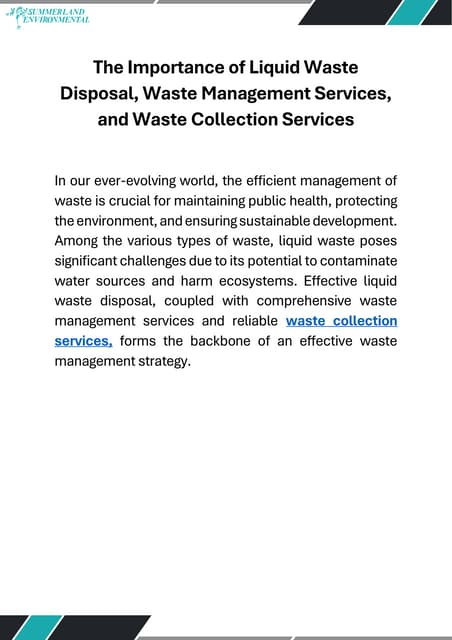8 Easy Facts About Reclaim Waste Described
8 Easy Facts About Reclaim Waste Described
Blog Article
Little Known Facts About Reclaim Waste.
Table of ContentsThe smart Trick of Reclaim Waste That Nobody is Talking AboutReclaim Waste - QuestionsFascination About Reclaim WasteReclaim Waste Can Be Fun For AnyoneEverything about Reclaim Waste
Explore the types, incidents, and forms of liquid waste. Residential sewer waste refers to the waste and products from a domestic septic tank. This kind of waste is created by human beings in homes, schools, and various other structures. This only consists of septic containers that have a drain field. The correct administration and disposal of domestic sewage waste require fluid waste to be moved to a sewer therapy plant where the correct approaches and equipment are used to cleanse and take care of waste.
Business waste typically includes possible risks, such as flammable products or a mixture of fluid and strong waste products, and calls for a more innovative and detailed disposal process. The disposal of business waste generally involves the purification of waste before transportation to make sure risk-free and appropriate disposal. Hazardous waste is developed from by-products and overflow of industrial procedures and manufacturing.
This kind of waste can not make use of the very same sewer monitoring transport or processes as septic or commercial fluids. The hazardous waste monitoring process needs the assessment and testing of liquid waste prior to it goes through the disposal process (liquid waste disposal melbourne). Overflow waste is the fluid waste that comes from runoff and excess stormwater in very booming locations or cities
Runoff waste can create contamination and flooding if not managed correctly. Making certain correct waste monitoring can protect against disasters and minimize environmental damage.
Facts About Reclaim Waste Uncovered
Get in touch with PROS Services today to find out about our waste monitoring and disposal services and the proper methods to look after the fluid waste you create.
(https://www.domestika.org/en/reclaimwaste1)This supposed 'wastewater' is not just an important source however, after treatment, will certainly be launched to our land, rivers or the ocean. Made use of water from bathrooms, showers, bathrooms, kitchen area sinks, laundries and industrial procedures is known as wastewater.

water used to cool machinery or clean plant and devices). Stormwater, a kind of wastewater, is drainage that streams from farming and city areas such as roof coverings, parks, yards, roads, courses and gutters into stormwater drains, after rain. Stormwater moves unattended directly to regional creeks or rivers, at some point reaching the sea.
The 5-Minute Rule for Reclaim Waste
In Queensland, the majority of wastewater is treated at sewage treatment plants. Wastewater is transported from residential or industrial websites through a system of sewage systems and pump terminals, recognized as sewage reticulation, to a sewer therapy plant.
The Division of Natural Resources encourages regional governments concerning handling, operating and preserving sewerage systems and therapy plants. In unsewered areas, neighborhood federal governments might call for householders to mount specific or family sewer treatment systems to treat residential wastewater from toilets, kitchens, washrooms and laundries. The Division of Natural Resources authorises using family systems when they are confirmed to be reliable.
A lot of stormwater receives no therapy. In some brand-new subdivisions, treatment of some stormwater to eliminate litter, sand and crushed rock has started making use of gross toxin catches. Wastewater treatment takes place in four phases: Removes strong issue. Bigger solids, such as plastics and other objects wrongly discharged to sewers, are gotten rid of when wastewater is gone through screens.
Wastewater after that moves into huge tanks where solids resolve and are eliminated as sludge. go to this site Grease and residue are skimmed from the surface. Uses tiny living microorganisms referred to as micro-organisms to damage down and eliminate staying dissolved wastes and great fragments. Micro-organisms and wastes are included in the sludge. Gets rid of nitrogen and phosphorus nutrients that can trigger algal blooms in our rivers and threaten marine life.
Some Known Details About Reclaim Waste
Nutrient removal is not readily available in all sewage therapy plants due to the fact that it needs expensive specialist tools. It is ending up being much more common in Queensland. Clear fluid effluent generated after treatment may still consist of disease-causing micro-organisms. If this effluent is released into rivers such as rivers or the sea, the micro-organisms will ultimately pass away out.

A lot of wastewater flows right into the sewage system. Under the Act, local governments provide authorizations and permits for ecologically pertinent tasks (Periods) including wastewater launches that could have a regional impact.
Everything about Reclaim Waste
Or else, examples are considered research laboratory evaluation. Often lots of examinations are needed to develop the degrees of each of the different pollutants such as oils, hefty steels and chemicals in water. Monitoring supplies accurate info concerning water high quality and can validate that permit problems are being met. The details gotten through surveillance provides the basis for making water top quality choices.
Report this page